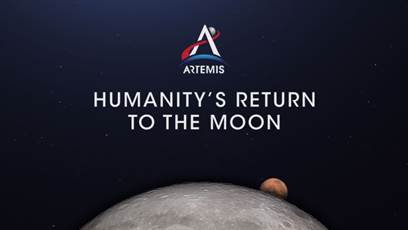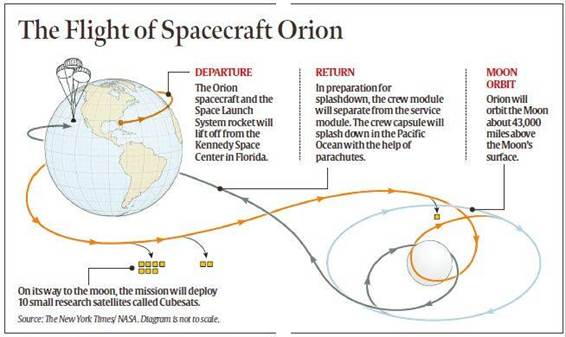Description

Disclaimer: Copyright infringement not intended.
Context
- NASA's next-generation moon rocket, the Space Launch System (SLS), with its Orion crew capsule on top, is readied for launch of the unmanned Artemis 1 mission at Cape Canaveral, Florida, U.S
Artemis program
- The Artemis program that began in 2017 is a United States-led international human spaceflight program.
- Its primary goal is to take humans to the Moon, specifically the lunar south pole, by 2025.
Details
- For the Artemis program, NASA’s new rocket called the Space Launch System (SLS) will send astronauts aboard the Orion spacecraft away from Earth to the lunar orbit.
- Once astronauts dock Orion at the Gateway — which is a small spaceship in orbit around the moon — the astronauts will be able to live and work around the Moon, and from the spaceship, astronauts will take expeditions to the surface of the Moon.
- The astronauts going for the Artemis program will wear newly designed spacesuits, called Exploration Extravehicular Mobility Unit, or xEMU. These spacesuits feature advanced mobility and communications and interchangeable parts that can be configured for spacewalks in microgravity or on a planetary surface.

Cubesats
- Artemis 1 is carrying several payloads in the form of small satellites called CubeSats, each of which is equipped with instruments meant for specific investigations and experiments. The focus of these investigations is clearly to explore long-term stays of human beings in space, and on the Moon. One CubeSat will search for water in all its forms, another will map the availability of hydrogen that can be utilised as a source of energy. Then there are biology experiments, investigating the behaviour of small organisms like fungi and algae in outer space, and the effect of radiation, especially the reaction on their genes.

Orion spacecraft
- The Orion spacecraft, which is specifically designed to carry astronauts into deep space on future missions, will have three dummy ‘passengers’ — mannequins made of material that mimic human bones, skin, and soft tissue. These would be equipped with a host of sensors to record the various impacts of deep space atmosphere on the human body.
Space Launch System, or SLS
- The rocket that is being used for the Artemis missions, called Space Launch System, or SLS, is the most powerful ever built, more powerful than the Saturn V rockets that had taken the Apollo missions to the Moon. The giant, 98-metre-tall rocket, weighing 2,500 tonnes, can help the Orion spacecraft achieve speeds of over 36,000 km per hour, and take it directly to the Moon, which is 1,000 times farther than the International Space Station that sees a regular traffic of astronauts.
Organizations involved
- The Artemis program is carried out predominantly by NASA and U.S. commercial spaceflight contractors, in partnership with the European Space Agency and the space agencies of several other nations.
- Other countries have been invited to join the program through signing the governing Artemis Accords, which remain open for signature since October 2020.
Artemis Accords
- This accord ensures that space exploration is conducted in a safe, sustainable and transparent manner and in full compliance with international law.
- As more countries establish a presence in outer space, via research stations, satellites, or even rocket launches, these accords provide a set of principles to create a safe and transparent environment that inspires exploration, science, and commercial activities.
- The other signatories to the accords are the U.S., Australia, Britain, Canada, Italy, Japan, Luxembourg, South Korea, the United Arab Emirates, and Ukraine. Brazil also said it plans to sign.
Final Thought
- If successful, the Artemis program will include the first crewed lunar landing mission since Apollo 17 in 1972, the last lunar flight of the Apollo program.
- The program will lay the foundations for the extraction of lunar resources, and eventually, make crewed missions to Mars and beyond feasible.
https://indianexpress.com/article/explained/explained-sci-tech/explained-significance-nasas-artemis-mission-beginning-human-exploration-moon-8119167/















